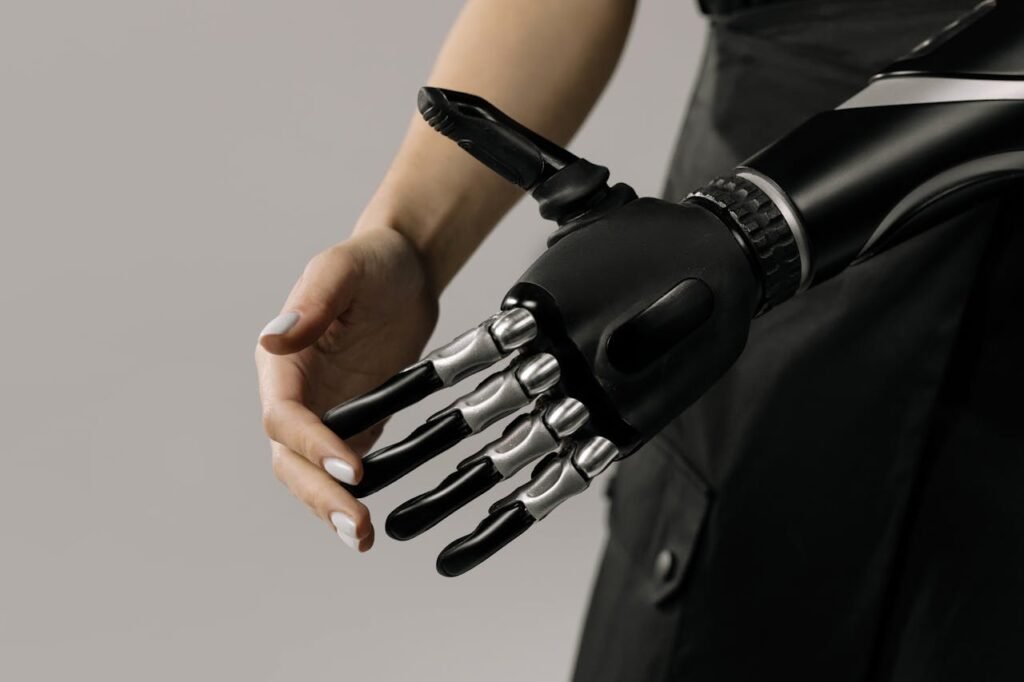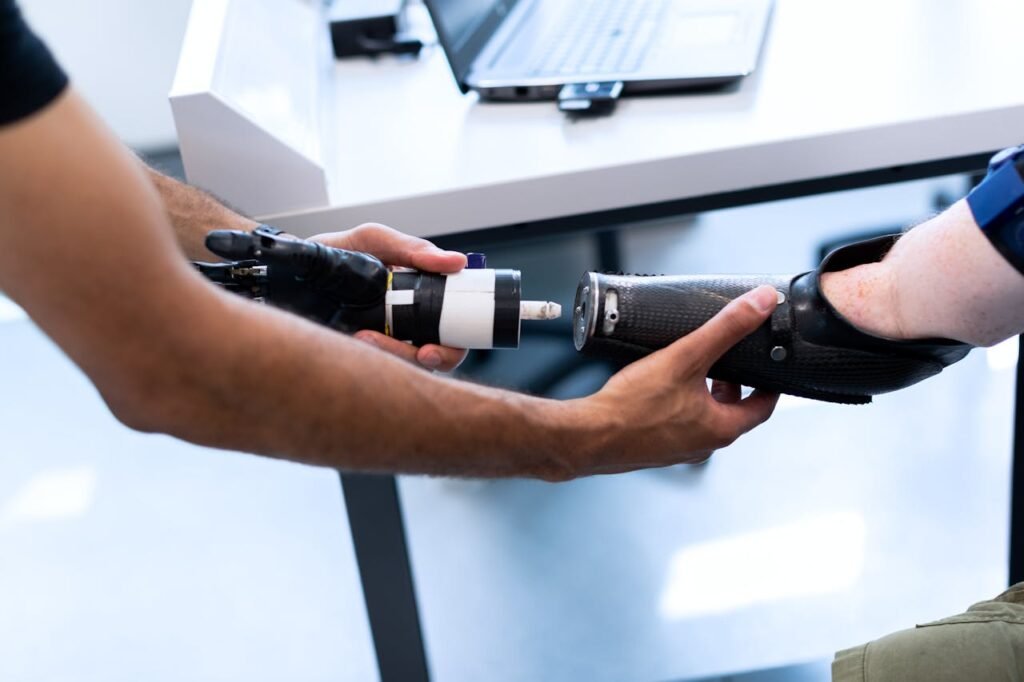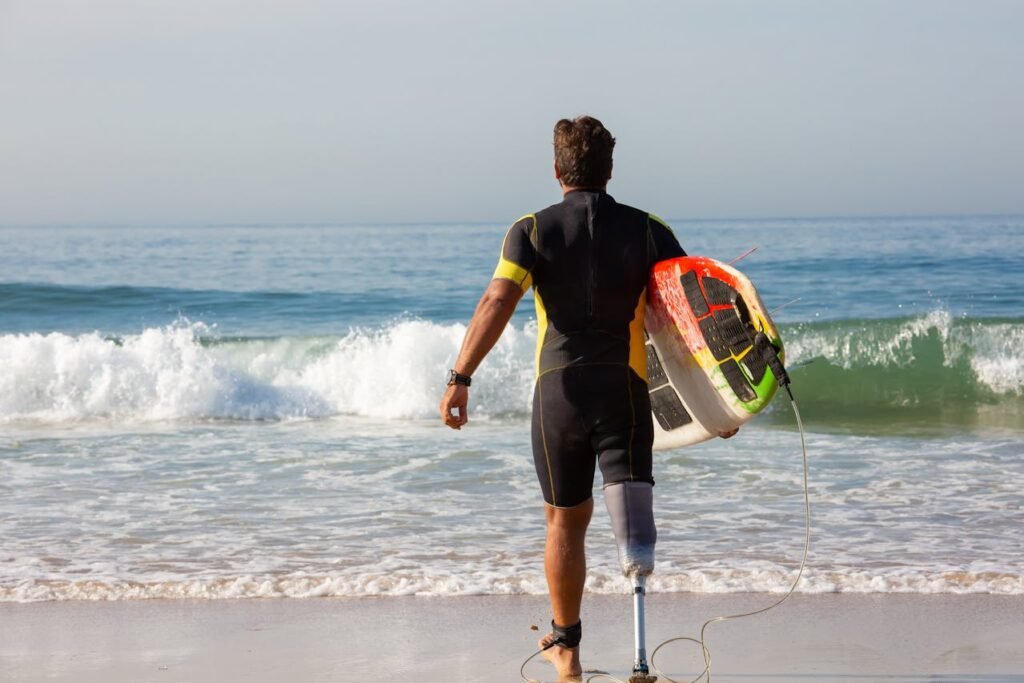Phantom limb pain is one of the most puzzling and frustrating problems people face after an amputation. Even though the limb is no longer there, the brain continues to send signals as if it still exists. For many, this pain feels sharp, burning, or cramping — and it can make daily life much harder.
Over the years, doctors and therapists have tried many treatments, from medications to mirror therapy. Some work for a while, others not at all. In recent years, Electrical Muscle Stimulation (EMS) has entered the picture as a possible way to ease phantom pain. By gently stimulating the residual muscles, EMS may help the brain focus on real signals instead of false ones.
But the big question remains — does it really work? In this article, we will explore phantom limb pain in detail, look at why it happens, and see how EMS fits into treatment. We will also discuss what patients, families, and rehab centers should know before starting EMS therapy, and how it can be used in both clinics and at home.
Understanding Phantom Limb Pain
What Phantom Limb Pain Feels Like

Phantom limb pain is different for each person. Some feel sharp stabbing pains, while others describe burning, tingling, or cramping. For many, the pain comes suddenly, even when the body is at rest. It can last for minutes or hours, making it unpredictable and difficult to manage.
Why the Brain Creates Pain in a Missing Limb
The brain controls every part of the body through nerve signals. After an amputation, the nerves that once carried signals to the missing limb remain active. These nerves still try to talk to the brain, but without real feedback, the brain gets confused. This confusion often shows up as pain in the part that is no longer there.
The Role of the Spinal Cord and Nerve Endings
When a limb is removed, the nerve endings in the residual limb become more sensitive. They may fire signals even without a trigger. These signals travel to the spinal cord and brain, which interpret them as pain. Because the brain remembers the missing limb, the pain feels like it is coming from that area.
Emotional and Psychological Triggers
Phantom pain is not only physical. Stress, fatigue, and emotional distress can make it worse. The brain and body are closely linked, and when the mind is under strain, pain signals often become stronger. This is why managing stress and mental health is an important part of treating phantom limb pain.
Why Phantom Pain Matters in Recovery
Beyond the discomfort, phantom limb pain slows recovery. It affects sleep, lowers energy, and reduces the motivation to exercise or use a prosthetic. Patients who struggle with constant pain often delay rehabilitation. This makes it harder to regain independence and can add emotional frustration on top of physical challenges.
Current Treatments for Phantom Limb Pain
Medications and Their Limits
The first line of treatment for many patients is medication. Doctors may prescribe painkillers, antidepressants, or anti-seizure drugs to calm nerve signals. While these can bring relief, they often have side effects like drowsiness, dizziness, or dependency. For many patients, medication helps only partly, leaving them searching for additional solutions.
Mirror Therapy
Mirror therapy has been used for years to reduce phantom pain. In this method, a mirror is placed so the reflection of the intact limb looks like the missing one. When the patient moves the intact limb, the brain sees both as moving. This visual trick helps retrain the brain, sometimes reducing false pain signals. But not everyone responds to mirror therapy, and its effects may fade over time.
Physiotherapy and Massage
Physical therapy helps by keeping the residual limb active and improving blood flow. Therapists may use massage, stretching, or gentle exercises to reduce nerve sensitivity. These methods are safe and supportive but may not always address deeper nerve-related causes of phantom pain.
Psychological Support
Because phantom pain is closely tied to the brain and emotions, counseling and stress management play a role. Techniques like cognitive behavioral therapy (CBT) or relaxation exercises help patients cope. They do not remove the pain completely, but they can reduce its intensity by lowering stress and improving sleep.
Surgical Options
In severe cases, doctors may suggest surgical procedures to calm or cut overactive nerves. This is often considered a last resort, as surgery carries risks and does not guarantee success. Many patients prefer to explore non-invasive options before reaching this stage.
How EMS Therapy Works
The Basics of Electrical Muscle Stimulation
EMS, or Electrical Muscle Stimulation, uses mild electrical pulses to activate muscles. Electrodes are placed on the skin of the residual limb, and when the device is switched on, the muscles contract as if the person were moving them voluntarily. These contractions are safe, controlled, and adjustable in strength depending on the patient’s comfort.
How EMS Differs From TENS
Many people confuse EMS with TENS (Transcutaneous Electrical Nerve Stimulation). TENS mainly targets nerves to block pain signals, while EMS focuses on contracting muscles. This difference is important because EMS does more than mask pain — it trains the muscles, improves blood flow, and stimulates the nervous system in ways that can influence phantom sensations.
The Role of Muscle Contractions in Healing
When muscles contract, even artificially, they send signals back to the brain. This constant feedback reminds the brain that the limb is still active in some way. Instead of relying on false signals from cut nerve endings, the brain receives real activity from the residual muscles. Over time, this reduces confusion and may ease phantom pain.
Why EMS May Help with Phantom Limb Pain
Refocusing the Brain’s Attention
One of the strongest theories about phantom pain is that the brain becomes too focused on the missing limb because it lacks real input. EMS helps redirect this focus. By stimulating the residual limb, the brain receives new, meaningful signals. This shift in attention can reduce the intensity of phantom sensations.
Calming Overactive Nerves
After an amputation, nerves in the residual limb often misfire, sending pain signals without a real cause. EMS provides structured stimulation, which helps regulate nerve activity. Instead of firing randomly, the nerves follow the rhythm of the EMS pulses, which can calm their overactivity over time.
Improving Blood Flow and Relaxation
Phantom pain often worsens when the residual limb feels tight, swollen, or cold. EMS improves blood circulation by contracting muscles like natural pumps. Better circulation warms the limb, reduces stiffness, and creates a more relaxed feeling. For many patients, this relief translates into less phantom discomfort.
The Science Behind EMS and Phantom Pain
Brain Plasticity and Neural Rewiring
The human brain is highly adaptable, a quality known as plasticity. After an amputation, the brain reorganizes itself to adjust to the loss. Sometimes this reorganization goes wrong, creating phantom pain. EMS takes advantage of this adaptability by giving the brain accurate muscle signals to reorganize around. This helps reduce the faulty wiring that contributes to pain.
Research and Clinical Observations
Studies on EMS for phantom limb pain are still growing, but early results are promising. Many trials show that patients using EMS experience lower pain intensity and greater comfort during rehabilitation. Clinicians also report that patients using EMS tend to sleep better and show more motivation in therapy, which adds indirect benefits.
Practical Evidence From Rehabilitation Centers
In clinics where EMS has been integrated into standard rehab, therapists observe not just reduced phantom pain but also faster progress toward prosthetic readiness. Patients often describe feeling “more connected” to their residual limb. While experiences vary, the consistent trend is that EMS offers meaningful relief where other therapies sometimes fall short.
Practical Application of EMS Therapy for Phantom Limb Pain
Using EMS in Clinical Settings

In rehabilitation centers, EMS is often introduced early in recovery. Therapists place electrodes on specific muscles of the residual limb and adjust the intensity based on comfort. Sessions usually last between 15 to 30 minutes, giving enough stimulation to activate the muscles without fatigue. What makes clinical use powerful is supervision — therapists can change settings, check responses, and combine EMS with other treatments like mirror therapy or stretching for maximum benefit.
Home-Based EMS Therapy
As patients become more confident, EMS can also be continued at home with portable devices. This gives them the flexibility to manage phantom pain outside the clinic. Home use works best when guided by a therapist who first explains electrode placement and session timing. Families often get involved too, helping with setup and ensuring sessions are done regularly. The ease of using EMS while reading, watching TV, or resting makes it convenient for daily life.
Session Frequency and Duration
There is no single schedule for everyone, but most patients benefit from three to five sessions per week in the early stages. Each session can last from 20 to 40 minutes, depending on tolerance. Over time, the frequency may decrease as phantom pain becomes less frequent. The key is consistency — short, regular sessions often bring better results than occasional long ones.
Customizing Intensity Levels
Not all phantom pain feels the same, and not all patients respond the same way. Some may prefer a very gentle pulse that feels like a light tingling, while others benefit from stronger contractions. The intensity should always stay within comfort levels. If the contractions feel painful, the setting is too high. Gradual adjustment is the safest way to find the sweet spot.
Combining EMS With Relaxation Practices
For many patients, EMS works even better when paired with relaxation techniques. Deep breathing during stimulation helps calm the nervous system, while guided meditation reduces stress signals that worsen phantom pain. This combination not only relieves pain but also improves sleep quality and emotional well-being.
Safety Considerations
While EMS is generally safe, there are important guidelines. Electrodes should never be placed on open wounds, irritated skin, or directly over bony areas. Patients with pacemakers or serious heart conditions should avoid EMS unless cleared by a doctor. It is also important to start with short sessions under supervision before moving to independent home use. With these precautions, EMS remains a safe and supportive therapy.
Integrating EMS Into a Broader Pain Management Plan
Complementing Traditional Therapies
EMS is not meant to replace medication, physiotherapy, or counseling, but to work alongside them. When integrated into a broader plan, its benefits multiply. For example, EMS can prepare the limb for stretching, or calm phantom sensations before sleep, reducing reliance on painkillers. Businesses that offer this holistic approach often see higher patient satisfaction.
The Role of Education in Long-Term Success
Patients who understand how EMS helps are more likely to use it consistently. Rehab centers should provide simple guides with diagrams for electrode placement, troubleshooting tips, and clear instructions on session timing. Education reduces fear, increases confidence, and empowers patients to take control of their recovery.
Business Opportunities for Clinics and Providers
For prosthetic clinics, rehab centers, and health-tech providers, EMS presents a unique opportunity. Offering EMS therapy sets a business apart as forward-thinking and patient-focused. Bundling EMS into rehabilitation packages, providing at-home devices with follow-up care, and documenting patient success stories can enhance both outcomes and reputation.
Long-Term Impact of EMS on Phantom Limb Pain
Sustaining Relief Over Time

For many amputees, the fear is not only the intensity of phantom limb pain but also its persistence. Some treatments bring short-term comfort but fade quickly. EMS, when used consistently, can provide lasting relief. Regular sessions keep the nervous system engaged, reducing the chance of pain signals returning as strongly. Patients who use EMS over months often report that the pain episodes become shorter, less frequent, and easier to manage.
Preventing Muscle Atrophy
Beyond phantom pain, amputees face another challenge — the gradual weakening of unused muscles. EMS helps prevent this by keeping residual muscles active. Stronger muscles mean better circulation, which indirectly helps reduce pain too. For patients preparing to use prosthetics, this strength is crucial. EMS, therefore, plays a dual role: easing phantom sensations while protecting the limb’s physical health.
Supporting Prosthetic Adaptation
When patients transition to prosthetic use, they need strong, responsive muscles to control the device. Phantom pain can make training difficult, as discomfort distracts from learning. EMS reduces this pain while simultaneously conditioning the muscles, making prosthetic training smoother. Patients often feel more confident because their limb feels “alive” and responsive rather than stiff and painful.
Enhancing Emotional Recovery
Living with phantom pain can be emotionally draining. It disrupts sleep, creates anxiety, and sometimes leaves patients feeling hopeless. EMS offers not just physical relief but also emotional reassurance. Watching muscles contract again — even artificially — gives patients visible proof of progress. Each session provides a sense of control over something that once felt uncontrollable. This emotional lift can be as important as the pain relief itself.
Building a Lifelong Routine
For long-term success, EMS should not be seen as a short-term fix but as part of a lifestyle. Just like exercise or healthy eating, it becomes a routine that supports overall well-being. Patients who make EMS part of their weekly schedule benefit not only from reduced phantom pain but also from stronger, healthier muscles. For many, this routine becomes the foundation for living independently and comfortably with a prosthetic.
The Broader Picture: What EMS Means for the Future
Shifting from Medication-Heavy Approaches
Traditional treatment for phantom limb pain often relies on medication, which can create dependency and side effects. EMS offers a safer, non-invasive option that reduces this reliance. For patients and healthcare providers alike, this shift is significant. It means less long-term expense on drugs and fewer complications from prolonged use.
The Role of Technology in Rehabilitation
EMS represents a larger movement in rehabilitation — the use of smart, accessible technologies to improve patient outcomes. By combining electrical stimulation with personalized therapy plans, clinics are showing that technology can humanize care rather than replace it. This shift aligns with the future of healthcare, where innovation and empathy work hand in hand.
Opportunities for Rehabilitation Centers
Rehab centers and prosthetic providers can integrate EMS as a standard part of their offerings. Doing so not only enhances recovery but also builds trust with patients and their families. Offering a therapy that reduces pain and prepares the body for prosthetic use creates a complete care package that few competitors provide. For businesses, this translates into stronger reputation and patient loyalty.
Does EMS Therapy Really Work for Phantom Limb Pain?
Looking at the Evidence

Research into EMS and phantom limb pain is still evolving, but early findings are encouraging. Clinical observations suggest that many patients feel noticeable relief after consistent use. The improvements are not only in reduced pain intensity but also in better sleep, smoother prosthetic adaptation, and increased emotional resilience. While EMS may not eliminate phantom pain for everyone, it often makes the discomfort manageable and less disruptive to daily life.
Patient Experiences
Stories from patients show how powerful EMS can be in practice. Many describe how their first sessions brought a sense of control they had lost since surgery. The sight and feel of the residual limb contracting again gives reassurance that the body is still capable of responding. For some, phantom pain reduced within weeks, while others found long-term use more effective. The consistency of these experiences makes EMS an increasingly trusted tool in rehab programs.
A Balanced Perspective
It is important to be clear — EMS is not a miracle cure. Phantom limb pain is complex, and no single therapy works for all patients. However, EMS offers unique advantages: it is non-invasive, drug-free, safe for most users, and can be combined with other therapies. When included as part of a structured rehabilitation plan, EMS significantly improves the chances of managing phantom pain effectively.
Conclusion
Phantom limb pain is one of the most challenging parts of recovery after amputation. It affects the body, the mind, and the journey toward independence. Medications and traditional therapies help, but they often leave gaps. EMS therapy fills many of those gaps by keeping muscles active, calming overactive nerves, improving circulation, and giving the brain real signals to focus on instead of false pain.
So, does it really work? The answer is yes — for many patients, EMS provides meaningful relief. It may not erase phantom pain completely, but it often makes it manageable, less frequent, and less intense. More importantly, it offers hope. Each contraction reminds patients that their body is not broken, just adapting.
At RoboBionics, we believe recovery is not about returning to what was lost but about moving forward with strength and dignity. EMS is one of the tools that makes this possible. It empowers patients, supports families, and gives rehabilitation centers a way to deliver faster, more effective care.
Phantom pain may begin as a challenge, but with the right tools, it does not have to define life after amputation. With EMS therapy, every session is progress, every contraction is strength, and every day is proof that healing is possible.



